Michigan’s Adventure – Muskegon, Michigan
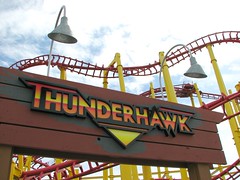 The Inuit language is said to have over 30 words to describe that substance we call snow, but the coaster enthusiast lexicon most easily has that record beat when it comes to describing roughness. What more is there for me to say about Vekoma SLCs? A search of any roller coaster review site will more than likely feature a fine selection of choice words epitomizing this most repudiated of theme park institutions. So rather than futilely attempt to equivocate further on the subject, I might be better off taking a postmodernist approach and start by declaring that there is nothing original left to be said about SLCs, mumbling something about the false presuppositions that founded modernity and then spending the rest of the article writing only in adverbs.
The Inuit language is said to have over 30 words to describe that substance we call snow, but the coaster enthusiast lexicon most easily has that record beat when it comes to describing roughness. What more is there for me to say about Vekoma SLCs? A search of any roller coaster review site will more than likely feature a fine selection of choice words epitomizing this most repudiated of theme park institutions. So rather than futilely attempt to equivocate further on the subject, I might be better off taking a postmodernist approach and start by declaring that there is nothing original left to be said about SLCs, mumbling something about the false presuppositions that founded modernity and then spending the rest of the article writing only in adverbs.
But before I begin my analysis of this redingly and yellowingly coasterly perception, a more important question I should ask is: what are the presuppositions that founded the popular opinion of SLCs? A closer inspection might reveal that once you tune out the chorus singing “rough, rough, rough” there’s not been a whole lot. That’s probably understandable since it’s hard to think of much of else to say about the ride when one’s earlobes have just been pounded into oblivion. So imagine my pleasant surprise when, on my first ride of Michigan’s Adventure’s Thunderhawk in May of 2008, I discovered that there is finally an SLC that doesn’t re-arrange your spinal column whenever you ride it. But even more surprising was discovering that, when you strip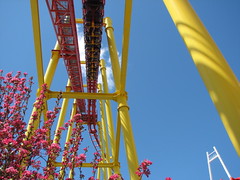 away all the unnecessary roughness, you will find an uncommonly decent roller coaster underneath it all.
away all the unnecessary roughness, you will find an uncommonly decent roller coaster underneath it all.
Yes, Michigan’s Adventure’s Thunderhawk is actually smooth, at least relatively speaking. Sure, the wheelbases still aren’t spring-loaded tight, and some of the transitions are clearly from the 1990’s, but my ears could easily avoid contact with the restraints throughout the entire ride. I’ve certainly been treated far worse on a few B&M inverts. So with that established, let’s begin the ride.
Cresting off of the lift hill is the wide right-hand swooping drop. It builds speed quickly, but it’s pretty much positive g’s all the way to the bottom due to the strong curvature and banking.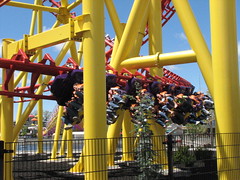 It’s hard to say for sure but I think if it were stretched out straight the drop angle wouldn’t be much more than 45° steep. The banking also doesn’t start until you’re already part of the way down as well, which can lead to some unexpected laterals off the top if you’re sitting in the back row (it’s a hard transition with no lead-in at the top as well).
It’s hard to say for sure but I think if it were stretched out straight the drop angle wouldn’t be much more than 45° steep. The banking also doesn’t start until you’re already part of the way down as well, which can lead to some unexpected laterals off the top if you’re sitting in the back row (it’s a hard transition with no lead-in at the top as well).
 The speed is sustained for a split second at the bottom of the drop as the track transitions out of the banking before surging up into the double rollover loop (we’ll label each of these inversions as “type 1”. You’ll see where I’m going with this a little later). I always admired the way it starts off with this maneuver, taking the same element that most other looping coasters (of its time, at least) began with, the vertical loop, but putting a literal and figurative twist on it, getting two inversions within one while extending the duration that this first element lasts making it a larger centerpiece within the context of the rest of the ride. Going back down the second half of the loop while sitting in the front seat, the rest of the cars still lagged behind and I was forced into a hangtime position as I faced directly down at the ground below with nothing between us but the restraints.
The speed is sustained for a split second at the bottom of the drop as the track transitions out of the banking before surging up into the double rollover loop (we’ll label each of these inversions as “type 1”. You’ll see where I’m going with this a little later). I always admired the way it starts off with this maneuver, taking the same element that most other looping coasters (of its time, at least) began with, the vertical loop, but putting a literal and figurative twist on it, getting two inversions within one while extending the duration that this first element lasts making it a larger centerpiece within the context of the rest of the ride. Going back down the second half of the loop while sitting in the front seat, the rest of the cars still lagged behind and I was forced into a hangtime position as I faced directly down at the ground below with nothing between us but the restraints.
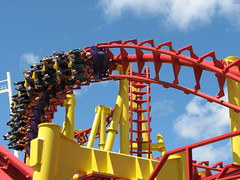 From here we pull up into a wide banked curving hill, a neat maneuver that allows one a breather between the breathless inversions that sandwich it on either side (label this curve as element “2”). We dive down far enough next to the station that a small trench is needed to keep our feet from skidding across the ground. The train then pulls back up into inversion
From here we pull up into a wide banked curving hill, a neat maneuver that allows one a breather between the breathless inversions that sandwich it on either side (label this curve as element “2”). We dive down far enough next to the station that a small trench is needed to keep our feet from skidding across the ground. The train then pulls back up into inversion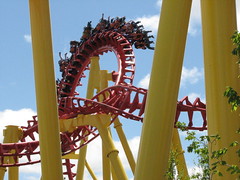 number three (which we’ll call, conveniently, #3). This one emulates to some degree the very first
number three (which we’ll call, conveniently, #3). This one emulates to some degree the very first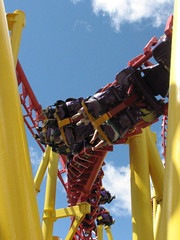 inversion, starting off as a loop before twisting around horizontally, and wider, rolling curve on the way out blends perfectly with the next element, a 270 degree carousel helix (#4). Again, a nice breather between elements and a chance to enjoy a bit of a flying sensation in the suspended seats. The banking rises a bit in the middle before falling slightly, rising again only to continue and flip us completely over our heads, a very close call with the exit track of inversion 3 for those sitting on the right side of the train. This is easily my favorite part of the ride, as the two barrel rolls (#5, each) are extremely rapid fire and fast-paced; very disorienting stuff. I especially love sitting on the right side, there are at least three or four very close encounters with nearby supports.
inversion, starting off as a loop before twisting around horizontally, and wider, rolling curve on the way out blends perfectly with the next element, a 270 degree carousel helix (#4). Again, a nice breather between elements and a chance to enjoy a bit of a flying sensation in the suspended seats. The banking rises a bit in the middle before falling slightly, rising again only to continue and flip us completely over our heads, a very close call with the exit track of inversion 3 for those sitting on the right side of the train. This is easily my favorite part of the ride, as the two barrel rolls (#5, each) are extremely rapid fire and fast-paced; very disorienting stuff. I especially love sitting on the right side, there are at least three or four very close encounters with nearby supports.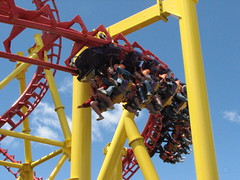
As soon as we’re finished with the second barrel roll, the ride suddenly transitions from its most intense moments to the most dull and pointless. We wrap things up with some noodling curves and s-curves, none of them really doing anything other than to distract us a bit as it tries to find its way back to the brake run. I suppose this section is fun for first-time riders who, after braving all the intense inversions that preceded it, can finally relax and enjoy some of the free-flight sensation, but more experienced riders will probably consider the ride as finished after the last barrel roll.
I remember when I first rode it when it was the big thing at Geauga Lake in 1999, I thought the old name  “Serial Thriller” was very fitting because this ride seemed to focus on a repetition of elements. I guess my main comparison point was with Raptor and other B&M inverts which always progressed from one different inversion type to the next, while Serial Thriller seemed to relish doing the same thing over and over. The first inversion is actually two, that double-rollover loop, and then the third inversion echoes the first, plus the obvious double barrel roll that ends the ride. In that regard, it makes a decent steel looping counterpart of Shivering Timbers, which is the definitive success story of repetition with variation.
“Serial Thriller” was very fitting because this ride seemed to focus on a repetition of elements. I guess my main comparison point was with Raptor and other B&M inverts which always progressed from one different inversion type to the next, while Serial Thriller seemed to relish doing the same thing over and over. The first inversion is actually two, that double-rollover loop, and then the third inversion echoes the first, plus the obvious double barrel roll that ends the ride. In that regard, it makes a decent steel looping counterpart of Shivering Timbers, which is the definitive success story of repetition with variation.
If we lay the sequencing of the elements out, we can see a nice pattern emerges. The numbers refer to the labels I gave each element in the ride description above. Red numbers represent the different types of inversions (and therefore intensity, disorientation or whatever you want to associate with them) while blue numbers represent non-inverting curving maneuvers (and therefore breathers, gracefulness, flying sensation, whatever else you want to associate with them).
1-1, 2, 3, 4, 5-5
A simple but effective formula to progress the ride while also coming full circle, each element fits within the context of the others (note the symmetry). Both the first drop and final turns are missing. The first drop I’ll consider as more of an anticipatory lead-in to this core of the ride, and the final turns don’t do anything at all for this sequence. Some designs (I don’t believe there’s any in North America) include a helix at the very end. I don’t see that adding anything to the ride, I think of the above part as being pretty tight and effective by itself and a helix seems like a pretty simple-minded solution to just drag the ride out more without adding anything to it. Of course I can’t make any final judgments on the helix add-on until I have been on one myself, which will probably be the Blue Tornado at Gardaland in spring 2010.
I do want to mention a few things about Thunderhawk specifically and how it integrates with the rest of Michigan’s Adventure. While I think the general overall placement within the park is a good one (that back corner of the park needed a big draw to offset the strong pull of the Shivering Timbers/Wolverine Wildcat corner on the other side) I don’t really care for how it looks. At Geauga Lake it had the cool lakeside setting, flying over ponds and marshes filled with tall grass and cattails. They easily could have done something similar at Michigan’s Adventure but instead of building it over the lake they just filled in a corner of the lake and now it flies over a flat bed of woodchips and concrete with the water well off to the side.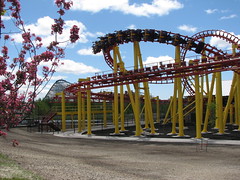 I guess that makes retrieving lost cell phones easier, but the coaster looks very dull and there’s not much of interest to look at from on-ride to lend to the whole “flying experience” the park has been billing it as. I mentioned in my Kings Island review how Cedar Fair seems to be taking a “high-class carnival ride” approach to the visual aesthetics of most of their new steel coaster attractions, and that’s especially true here. (In their defense, the park was never much more than that to begin with throughout their history, and they’ve only just started taking steps towards integrating a bit more character in recent years since Cedar Fair bought them in 2001).
I guess that makes retrieving lost cell phones easier, but the coaster looks very dull and there’s not much of interest to look at from on-ride to lend to the whole “flying experience” the park has been billing it as. I mentioned in my Kings Island review how Cedar Fair seems to be taking a “high-class carnival ride” approach to the visual aesthetics of most of their new steel coaster attractions, and that’s especially true here. (In their defense, the park was never much more than that to begin with throughout their history, and they’ve only just started taking steps towards integrating a bit more character in recent years since Cedar Fair bought them in 2001).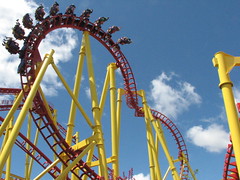
Unfortunately on my most recent visit in September of 2009, I noticed the ride had picked up much more of a shuffle than it did the year before. While it’s still not intolerably rough, the external ‘noise’ of the cars jostling us around make it harder to feel what the individual elements are trying to do. But there’s an interesting story here. On that visit my dad and I went with his brother and his family, and all of my cousins on that side of the family have a tradition of being some of the biggest scaredy-cats you could find when it comes to coasters. One of my cousins a few years ago was at a local fair, and there was one ride he wanted to try but was unsure if he could handle it. He spent the greater part of the afternoon working up the courage, and finally decided to go ride it. He came back and was asked how it was.
and finally decided to go ride it. He came back and was asked how it was.
“I didn’t ride it after all,” he said.
“Why not?”
“They said I was too tall.”
Needless to say I figured a Thunderhawk ride was out of the question, especially after I sampled it on my own and discovered it wasn’t running as well as it had been the year before, although they had been to a few Disney parks and had done some of the coasters there and that went over well, so I thought perhaps we could eventually work up to even a Shivering Timbers ride. We stuck to Zach’s Zoomer for a few rides, eventually made it to Corkscrew (“That was easy, you could hardly 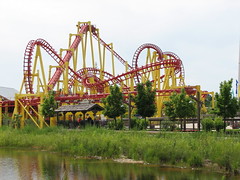 notice the loops if you weren’t looking”), then up to Wolverine Wildcat, and then Shivering Timbers. No problem. They wanted to try Thunderhawk. After our first ride, he declared that it was awesome and wanted to ride it immediately again. My younger cousin loved it as well. Shivering Timbers didn’t even get that much praise from them. I asked them if they thought it was at all rough or uncomfortable, and none of them reported any problems with it whatsoever. I guess this stuff is fairly relative. As for my own opinions of the ride, while Thunderhawk is a fine addition for the park and is very popular with the crowds, I’ll still take that woodingly, air-timely coasterly perception called Shiveringly Timbersly any day of the week.
notice the loops if you weren’t looking”), then up to Wolverine Wildcat, and then Shivering Timbers. No problem. They wanted to try Thunderhawk. After our first ride, he declared that it was awesome and wanted to ride it immediately again. My younger cousin loved it as well. Shivering Timbers didn’t even get that much praise from them. I asked them if they thought it was at all rough or uncomfortable, and none of them reported any problems with it whatsoever. I guess this stuff is fairly relative. As for my own opinions of the ride, while Thunderhawk is a fine addition for the park and is very popular with the crowds, I’ll still take that woodingly, air-timely coasterly perception called Shiveringly Timbersly any day of the week.
For anyone curious, Adverbialism was an actual trend that started sometime in the 80’s. The argument for it went something like this, “when we talk about an object we are not talking about the thing-in-itself, which is impossible, but we are only talking about the sense-impressions that occur to us. Therefore, nouns express a confidence in ontological being that we should no longer accept and should use adverbs which only describe the sensations relative to the seer.”
Needless to say the trend didn’t last.
I love that story about your cousin (whose name shall not be revealed for danger of embarrassment). I am glad to know he conquered his fears. Maybe you can talk him into Top Thrill Dragster sometime soon!
I’m sure we’ll be able to, mom.
Adverbialism… huh, I’m learning too much.
It’s interesting the Thunderhawk would experience a brief reprieve after being dismantled and reassembled. My ride was from when it was at Geauga Lake. It was too rough to know what was really happening. The only part I remember is that sideways move up in the air kind of like a camelback. That part alone felt very successful. So I can see how you describe it as having a legitimate design underneath the roughness.
Too bad someone couldn’t come along like the Gravity Group and design new trains for it.
I went on it in it’s last year at Geauga Lake and it was very smooth then as well.
By the way, Vekoma has already done the job themselves of designing new trains for the SLCs. It’s just a matter of if the parks want to pay for them, which most don’t.
That’s right. I remember now. Didn’t Morey’s Piers buy them? Having those Nascar like restraints alone should be a help because there’s nothing to bang your head on.
Flight of Fear is still rough but betting rid of the horse collars brought it from unacceptable to re-ridable.
So anyhow, I’m glad you dared to look beyond the obvious with this SLC.
I have to pee.